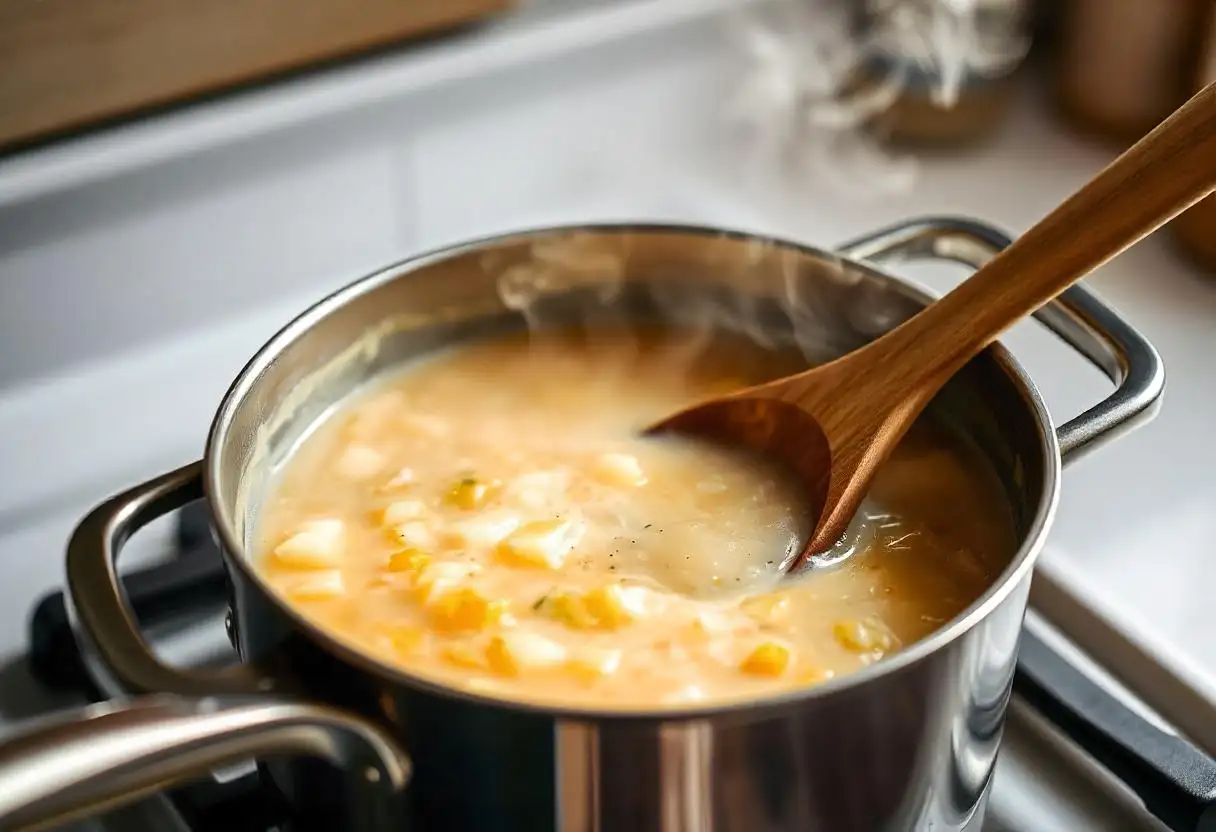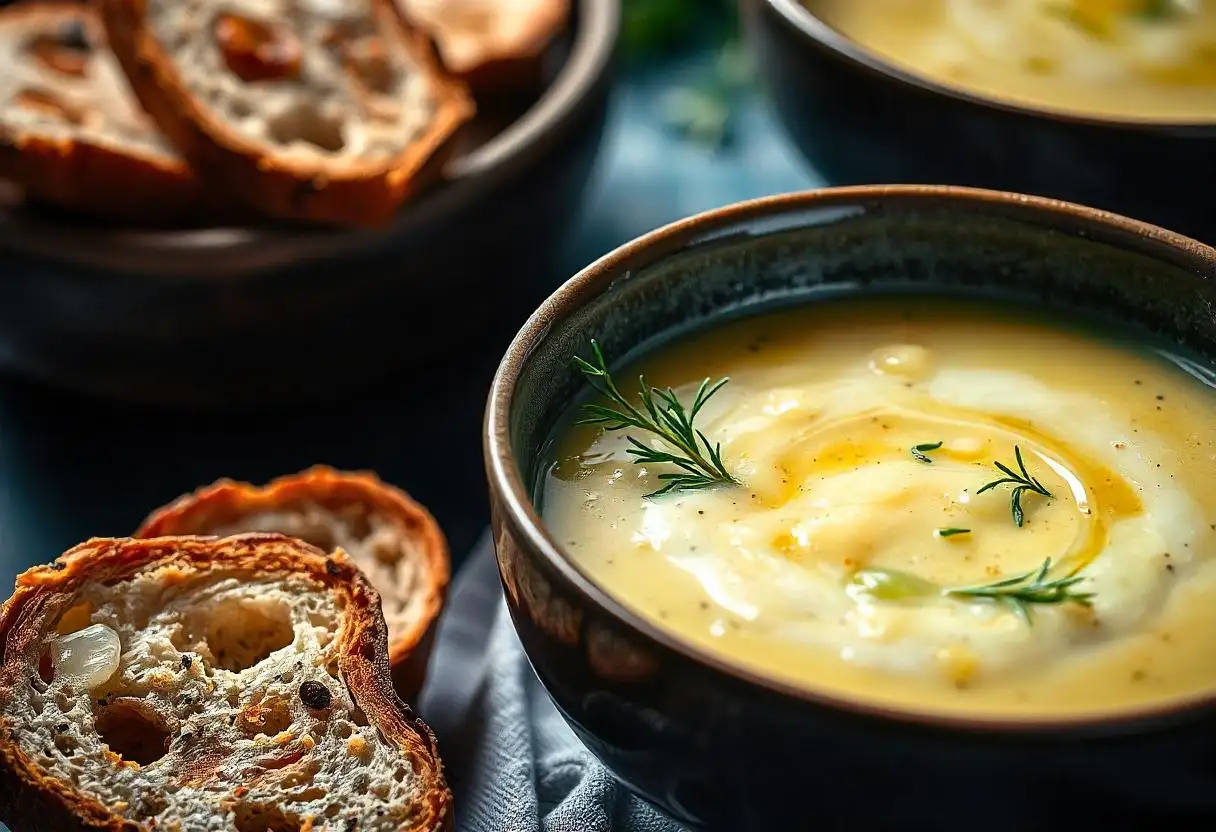Okay, let’s get real, amici. Some weeknights? Mamma mia! Between soccer practice, homework battles with Luca, Mia deciding dinner prep time is perfect for an impromptu concert, and Mike asking “What’s for dinner?” for the fifth time… having a freezer stash is basically my superpower. Pulling out a homemade meal feels like winning the lottery! Freezing soups is a total game-changer. But that creamy, dreamy leek and potato soup… it feels delicate, right? It begs the question: Is it ok to freeze leek and potato soup? And more importantly, can we do it without ending up with a sad, watery mess later? Spoiler alert: Yes! But stick with me, I’ve got the scoop (pun intended!).
Can You Freeze Leek and Potato Soup?
Let’s get right to it: Is it ok to freeze leek and potato soup? YES! You absolutely can! It’s a fantastic way to save those delicious leftovers, get ahead for a busy week, or make the most of gorgeous seasonal leeks. But, and it’s a little but, potato-based soups can be a tad dramatic about freezing. Sometimes those potatoes get a little… weird texturally. And if you’ve added cream, it can sometimes do a funny separation thing upon thawing. Don’t panic! These are totally solvable problems. We’re going to chat about how to freeze it smartly so it stays delicious.
The Science Behind Freezing Soup
Okay, quick science detour – don’t worry, no lab coats required! Freezing basically hits the pause button on spoilage by slowing everything way down. When we freeze soup, the water inside turns into ice crystals. Now, potatoes have a lot of water, so those ice crystals can sometimes mess with their texture, making them a bit grainy or mushy when thawed. Think about how a frozen strawberry gets softer after thawing – similar idea!
And cream? Well, fat and water don’t always stay perfectly mixed when frozen and thawed, leading to potential separation. Leeks, thankfully, are pretty chill about being frozen! But knowing why these things happen helps us outsmart them! We’ve got tricks up our sleeve to keep that soup smooth and yummy.
Steps to Freeze Leek and Potato Soup
Alright, let’s get practical! Freezing your delicious soup is easy peasy with these steps:
- Cool Your Jets!: This is super important! Let your soup cool down completely before it goes anywhere near the freezer. Putting hot soup in can mess with the freezer temp and isn’t safe for other foods. Patience, my friends!
- Portion Power: Think about how you’ll use it later. Freeze in single servings for quick lunches (perfect for me or Mike!) or larger family-sized portions for easy dinners.
- Container is Key: Choose your weapon! You need something airtight to protect your soup from dreaded freezer burn.
The Best Containers for Freezing Soup
Choosing the right container makes all the difference for happy frozen soup! Here are my favorites:
- Mason Jars (Wide-Mouth): Great for single servings, reusable, and look nice! Crucial tip: Leave at least an inch of headspace at the top for expansion, otherwise… crack! (Ask me how I know…). Use jars specifically labeled as freezer-safe if possible.
- Freezer-Safe Bags (Zip-Top): Brilliant space savers! Ladle soup in, squeeze out excess air, seal tight, and freeze flat. Once frozen, you can stack ’em like books! I sometimes double-bag just in case of leaks.
- Tupperware/Plastic Containers: Practical and reusable. Make sure they’re specifically labeled freezer-safe (some plastics get brittle when frozen) and have tight-fitting lids.
Whatever you choose, airtight is the goal to keep freezer burn away! Need more freezing tips? Check out this handy guide on The Best Way To Freeze Soups & Chilis For Later.
Labeling and Storing Soup in the Freezer
Okay, don’t skip this step, trust me! Future You will thank Past You. Grab a permanent marker and label each container or bag with “Leek & Potato Soup” and the date you froze it. No more mystery meals pulled from the depths of the freezer six months later! Store bags flat until frozen, then stack ’em up. Containers stack nicely too. An organized freezer is a happy freezer (and makes finding dinner way easier!).
How Long Does Leek and Potato Soup Last in the Freezer?
So, you’ve done the work, your soup is chilling out in the freezer – how long is it good for? For the best quality and flavor, aim to use your frozen leek and potato soup within 2-3 months. Can it last longer? Technically, yes, it’ll likely still be safe to eat if your freezer stays consistently cold. But after 3 months, the texture and flavor might start to fade a bit. That label with the date? Super helpful now! Use the oldest stash first – first in, first out!
Reheating Frozen Leek and Potato Soup
Alright, dinner time! You’ve got that lovely frozen block of homemade goodness. How do we bring it back to life? Reheating leek and potato soup is simple:
- Thaw First (Ideal Method): If you plan ahead (go you!), move the frozen soup container from the freezer to the fridge the night before. Slow thawing is gentlest on the texture.
- Straight From Frozen (When Life Happens!): No time to thaw? No worries! Pop the frozen block directly into a saucepan over low to medium-low heat. Add a tiny splash of water or broth to prevent sticking. Cover and let it gently melt, breaking it up with a spoon as it thaws, stirring occasionally.
- Stovetop Simmer: Once thawed (or mostly melted), heat the soup gently over medium heat, stirring often, until it’s steaming hot all the way through. Don’t boil it vigorously, especially if it contains cream.
- Microwave Magic (Quickest): You can also reheat thawed soup in the microwave. Use a microwave-safe bowl, cover loosely, and heat in bursts, stirring in between, until piping hot.
Whichever method you use, make sure it’s heated thoroughly before serving. A little taste test (careful, it’s hot!) to check seasoning is always a good idea too – sometimes freezing can dull flavors slightly.
Why Doesn’t Potato Soup Freeze Well?
Let’s revisit that potato texture issue. Why can potato soups be finicky freezers? It really comes down to those pesky ice crystals forming from the water inside the potato cells. When thawed, the damaged cells can make the potato pieces feel watery, mushy, or sometimes even a bit grainy. It’s not spoiled, just… texturally different. If the soup is fully blended, this is less noticeable, but if you have chunks of potato, you might see it more. Similarly, cream or milk can separate because the fat globules don’t like being frozen and thawed with water. Understanding this helps explain why sometimes a thawed soup might seem bland or less appealing – the texture change impacts our perception!
Ways to Avoid Issues When Freezing
So, how can we minimize these potential freezer dramas with our precious leek and potato soup? Here are my go-to tricks:
- Choose Waxy Potatoes: Potatoes labeled “waxy” (like Yukon Gold, Red Bliss, Fingerlings) generally hold their structure better during freezing than starchy ones (like Russets).
- Hold the Cream!: If your recipe calls for cream, milk, or yogurt, consider leaving it out before freezing. Freeze the soup base, then stir in the dairy when you reheat it. This is the best way to avoid separation!
- Blend it Smooth (or Partially): A fully puréed soup generally freezes and reheats more smoothly texture-wise than a chunky one. Or, blend about half the soup smooth and leave the rest chunky – a good compromise!
Tips for Freezing Leek and Potato Soup Successfully
Let’s gather a few more pearls of wisdom to ensure your frozen soup is always delizioso!
Use of Blanching or Partially Cooking
This is getting a bit fancy, but some folks swear by blanching veggies before adding them to a soup meant for freezing. Blanching (a quick dip in boiling water, then ice water) helps preserve texture and color by stopping enzyme activity. Honestly, for leek and potato soup, I find just cooking the soup normally works fine, but gently sautéing the leeks until just soft before adding to the simmering pot definitely helps maintain their lovely flavour.
Alternatives to Cream in the Soup
If you really want that creamy texture but are worried about freezing dairy, you have options! As mentioned, add the cream after thawing. Or, make the soup creamy without dairy before freezing: blend in a small amount of soaked cashews, use full-fat coconut milk (it might add a slight coconut flavor), or simply rely on well-cooked, starchy potatoes blended super smooth to provide natural creaminess. A swirl of good olive oil stirred in before serving also adds richness!
How Long Will Homemade Leek and Potato Soup Keep in the Fridge?
Okay, freezer talk aside, what if you just want to keep leftovers in the fridge? Easy! Once cooled completely, store your homemade leek and potato soup in an airtight container in the refrigerator. It should stay fresh and delicious for about 3 to 4 days. After that, the quality might decline, and it’s always best to err on the side of caution. Give it the sniff test – if anything seems off, toss it out. Better safe than sorry!
Why Does My Leek and Potato Soup Taste Bitter?
Uh oh! A bitter taste in your cozy soup? That’s no fun! What could be causing that unpleasant edge? Here are a few possibilities:
- Spice Issues?: Less common, but sometimes certain spices, if old or used too heavily, could contribute.
If your soup isn’t bitter, just boring, check out my tips on why is my leek and potato soup bland?
How to Fix Bitterness in Soup
Okay, don’t dump that pot just yet! If your soup tastes a little bitter, try these rescue remedies:
- Dilute (Carefully): If it’s really strong, you could try adding a bit more broth or water, but be careful not to make it bland! You’ll need to re-season.
Start small with these fixes and taste as you go – hopefully, you can bring it back to deliciousness!
FAQs
Got a few more quick questions? Let’s tackle ’em!
Q: Can you reheat leek and potato soup from frozen?
A: Si, absolutely! Best way is to thaw it in the fridge overnight, then gently reheat on the stove until piping hot. In a rush? You can reheat straight from frozen on low heat on the stove, breaking it up as it melts, or carefully in the microwave, stirring often. Easy peasy!
Q: Why doesn’t potato soup freeze well?
A: It’s those potatoes! They have lots of water, which forms ice crystals when frozen. When thawed, this can make the potato texture a bit grainy or mushy sometimes. Using waxy potatoes (like Yukon Golds) helps, as does blending the soup smooth, or adding cream after thawing instead of before freezing.
Q: How long will homemade leek and potato soup keep in the fridge?
A: Leftovers are the best! Store your cooled soup in an airtight container in the fridge, and it should be delicious for about 3 to 4 days. After that, best to be safe and toss it. And hey, wondering about using those dark green leek parts? Check out my thoughts on whether can you use dark green leeks in soup?
Q: Why does my leek and potato soup taste bitter?
A: Mamma mia, bitter soup is no good! It could be slightly burnt leeks (cook ’em gently!), older potatoes, or maybe just an off balance of flavors. Try fixing it with a squeeze of lemon juice, a pinch more salt (or even sugar!), or stirring in some cream. Need more troubleshooting? This article on >how to fix a bitter soup> might help!
So, there you have it, my lovely home cooks! Is it ok to freeze leek and potato soup? A big, hearty YES! With a few simple tricks – cooling it properly, choosing the right container, maybe holding the cream until reheating – you can absolutely stock your freezer with this comforting classic. No more worrying about texture changes or sad, separated soup! Now you can enjoy that delicious, homemade goodness whenever the craving strikes (or whenever life gets crazy!). Go forth, make a big batch, and embrace the magic of the freezer! Buon appetito!






Leave a Reply